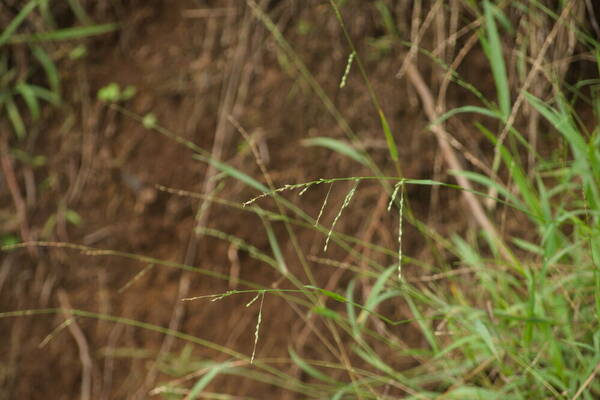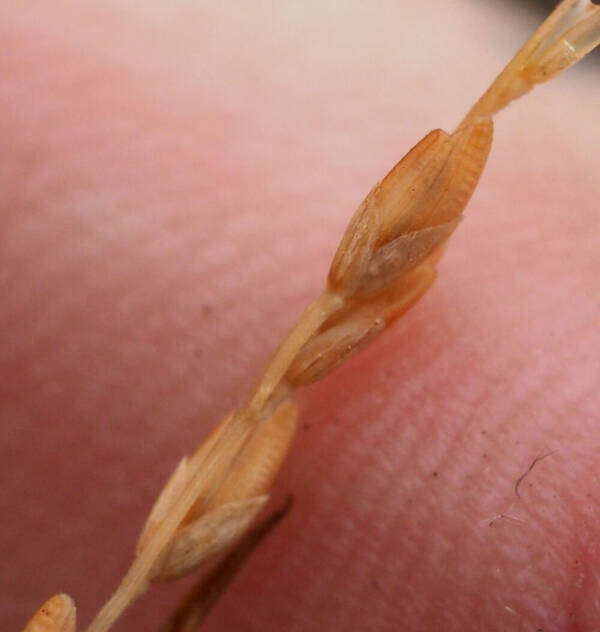Info
Subfamily: Ehrhartoideae
Genus etymology: Ehrharta = honorific for Jakob Friederick Ehrhart (1742–1795)
Species etymology: erecta = "upright" [Latin] refering to the inflorescence
Photosynthetic type: C3 (cool season)
Nativity: naturalized - intentional
First recorded in Hawaiʻi: 1979
Map

Inflorescence



Habit



Spikelets





Description
A rather variable caespitose perennial. Culms 40-100 cm. tall, 4-6-noded, usually geniculately ascending from a decumbent base, often rooting from the lower nodes, branched from below, slender, rather weak, smooth, glabrous or scattered pilose. Leaf-sheaths tight at first, later slipping off the culm, shorter than the internodes, striate, smooth, glabrous or scattered pilose. Ligule 4-7 mm. long, obtuse or truncate, often lacerate. Leaf-laminae 4-20 x 0·2-1(1·5) cm., very narrowly lanceolate to linear, auricled at the base, tapering to a fine soft point, usually expanded, rather flaccid, glabrous or very rarely scattered pilose, smooth or asperulous. Panicle 6-20 cm. long, erect, rarely nodding, open or contracted, irregularly elliptic to almost linear in outline, somewhat stiff; rhachis terete below, obtusely angular above, smooth or very rarely scaberulous; branches distant, very unequal, 2-3-nate or solitary, simple or sparingly branched, usually ascending to almost appressed to the rhachis, rarely spreading, flexuous, filiform, smooth or rarely scaberulous towards the apex. Pedicels up to 1 cm. long, capillary. Spikelets (3)4-5·75(-6·8) mm. long, light green, oblong in outline. Glumes unequal; the inferior 3-3·6 mm. long, 3-nerved but sometimes with short additional nerves on either side close to the margins, ovate-lanceolate, obtusely keeled, apex obtuse to rarely apiculate; the superior 3·5-4·5 mm. long, ovate to ovate-elliptic, 5-nerved, apex subobtuse to acute. Sterile lemmas (1 and 2) slightly unequal, muticous, with the flanks corrugated to a varying degree to completely smooth, sometimes scabrous or very slightly hispidulous, faintly 5-nerved; the inferior c. 5·4 mm. long, with the apex subacute in profile; the superior c. 6·5 mm. long, with a conspicuous basal hinge-like appendage, apex subobtuse in profile. Fertile lemma (the 3rd.) c. 5·5 mm. long, 5-nerved (sometimes with 1 short additional nerve on either side close to the margin), often cross-veined, ovate-elliptic, with the apex obtuse to subacute, keel scaberulous. Palea deeply cymbiform, scaberulous along the keels. Lodicules very small, usually broadly lobed, glabrous. Stamens 6; anthers 1·5-2 mm. long. Caryopsis c. 2 mm. long.
(Description source: Launert, E. & Pope, G.V. (eds.). 1989. Flora Zambesiaca. Volume 10. Part 3. Kew, London. 152 pp )
Plants perennial; weakly cespitose. Culms (20)30-100(200) cm, erect or ascending from a decumbent base, sometimes rooting at the lower nodes. Sheaths finely striate, glabrous or shortly pubescent; auricles ciliate; ligules to 3 mm, lacerate, glabrous; blades 5-15 cm long, 2-15 mm wide, flat, lax, usually glabrous, smooth or minutely roughened, margins often wavy. Panicles 5-21 cm, erect or nodding, open to contracted; pedicels usually straight, sometimes curved. Spikelets 3-5 mm, oval, greenish. Glumes unequal, membranous to chartaceous; lower glumes 1-2 mm, 1/3 – 2/3 the length of the spikelets, 3-5-veined; upper glumes 2-2.5 mm, to 3/4 the length of the spikelets, wider than the lower glumes, 5-veined; sterile lemmas 2.5-4.5 mm, indurate, glabrous or sparsely hispidulous, unawned, lower sterile lemmas often with a basal appendage, upper sterile lemmas transversely rugose distally; bisexual lemmas 2.5-3.5 mm, firm, glabrous, obscurely 5-7-veined, often cross veined, unawned; anthers 6, 0.7-1.2 mm. Caryopses about 2 mm. 2n = 24.
(Description source: Barkworth, M.E., Capels, K.M. & Long, S. (eds.) 1993. Flora of North America, north of Mexico. Volume 24. Magnoliophyta: Commelinidae (in part): Poaceae, Part 1. Oxford University Press, New York. 911 pp. http://floranorthamerica.org/Ehrharta_erecta )